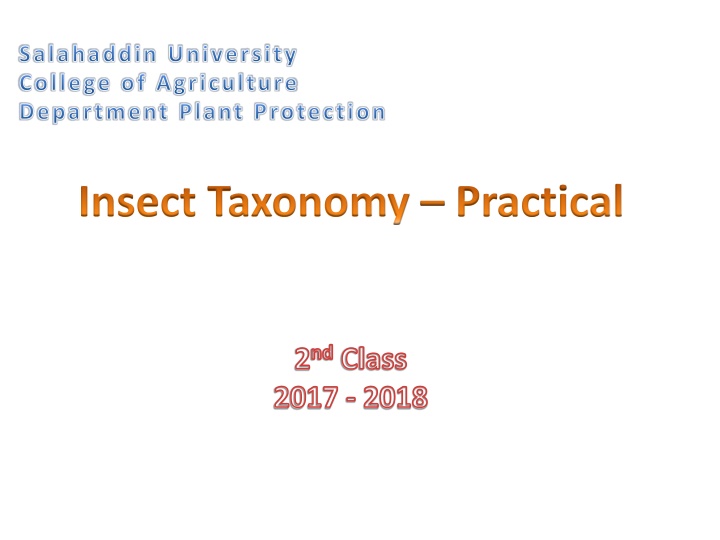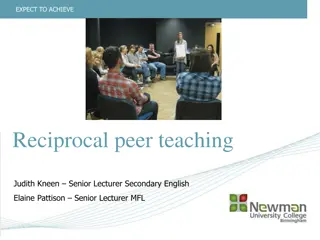
Insect Taxonomy: Classification of Orders in Agriculture Department
Explore the classification of insects into different orders in the field of Agriculture, focusing on key characteristics and scientific classifications of Thysanura (Silverfish), Protura (Telsontails), Diplura, and Collembola (Springtails). Learn about the main features used to identify insects to order, such as wings, mouth parts, and life history stages.
Download Presentation

Please find below an Image/Link to download the presentation.
The content on the website is provided AS IS for your information and personal use only. It may not be sold, licensed, or shared on other websites without obtaining consent from the author. If you encounter any issues during the download, it is possible that the publisher has removed the file from their server.
You are allowed to download the files provided on this website for personal or commercial use, subject to the condition that they are used lawfully. All files are the property of their respective owners.
The content on the website is provided AS IS for your information and personal use only. It may not be sold, licensed, or shared on other websites without obtaining consent from the author.
E N D
Presentation Transcript
Salahaddin University College of Agriculture Department Plant Protection Insect Taxonomy Practical 2ndClass 2017 - 2018
The principles of the classification of Insects Orders The characters most useful for identifying insects to order are:- 1-wings, their development, texture, venation and number. 2-Mouth parts, if they are chewing, sucking, or other modified type. 3-The kind of life history and immature stages
The classification of the insects Orders Kingdom: Animalia Phylum: Arthropoda Subphylum: Mandibulata or Uniramia Class: Insecta (is divided into (2) subclasses) Subclass: Apterygota (which is divided into (4) Orders) Order: Thysanura (Bristetails) Order: Protura (Telsontails) Order: Diplura Order: Collembola (Springtails)
1- Order: Thysanura (Silverfish) The classification of order Thysanura Kingdom Animalia Phylum Arthropoda Subphylum Hexapoda Class Insecta Order Thysanura (also known as Zygentoma) Family: Lepismatidae Genus: Lepisma Species: saccharina
The main characteristics of order: Thysanura 1- Body elongated and oval shaped, soft, flatted from top to bottom. 2- They are silvery to brown color. 3- have (2) long antenna and (3) long tail.
2- Order: Protura (Telsontails) Scientific classification:- Kingdom: Animalia Phylum: Arthropoda Class: Insecta Order: Protura Main characteristic :- 1- tiny( less than 2 mm body length) 2- pale, usually white or off-white, soft body. 3- wingless, no eyes, no antenna 4- enlarged forelegs.
3- Order: Diplura Scientific classification Kingdom: Animalia Phylum: Arthropoda Class: Insecta Order: Diplura Main characteristic 1- small narrow, elongate body, colourless. 2- wingless, eyes absent. 3- long antenna, and with (2) cerci.
4- Order: Collembola (Springtails) Scientific classification Kingdom: Animalia Phylum: Arthropoda Class: Insecta Subclass: Apterygota Family: Hypogastruridae Genus: Hypogastrura Species: nivicola
Main characteristic 1- antenna (4-6) segment and abdomen (6) segment. 2- Collophore in 1stabdominal segment. 3- Tenaculum in 3rdabdominal segment. 4- Furcula (Springtail) in 4thabdominal segment. 5- Body frequently covered with scales. . Thorax 1 2 3 4 5 6 CollophoreFurcula (springtail)
The classification of the insects orders: 2- subclass: Pterygota is divided into two divisions:- A- Division: Exopterygota- insects with simple metamorphosis B- Division: Endopterygota- insects with complete metamorphosis Note:- Each division contains many orders.
Division(A): Exopterygota Exopterygota includes these orders: 1- Order: Ephemeroptera 2- Order: Odonata 3- Order: Orthoptera 4- Order: Isoptera 5- Order: Dermaptera 6- Order: Mallophaga 7- Order: Anoplura 8- Order: Hemiptera 9- Order: Homoptera 10- Order: Thysanoptera 11- Order: Embioptera 12- Order: Pscoptera 13- Order: Zoraptera
Division (B): Endopterygota 1- Order: Coleoptera 2- Order: Lepidoptera 3- Order: Diptera 4- Order: Hymenoptera 5- Order: Neuroptera 6- Order: Siphonoptera 7- Order: Tricoptera 8- Order: Mecoptera 9- Order: Strepsiptera.
2- subclass: Pterygota 1- Division: Exopterygota 1- Order: Orthoptera Classification of this order Kingdom: Animalia Phylum: Arthropoda Class: Insecta Order: Orthoptera 1- Suborder: Ensifera 2- Suborder: Caelifera
The characteristics of the order: Orthoptera 1- (2) pairs of wings or wingless. 2- The body elongated. 3- Many species have large long ovipositor as long as the body; the cerci are usually well developed 5- Mouth parts are of the chewing type. 6- incomplete metamorphosis.
1-suborder:Ensifera (divided into (4) Family are) 1-Family:Rhaphidophoridae (Cave [camel] crickets) 2-Family:Tettigoniidae (Long-horned grasshopper)
3-Family:Gryllidae (Crickets) 4-Family: Gryllotalpidae (Mole Crickets)
2-suborder:Caelifera (divided into (2) Family are) 1-Family:Tetrigidae 2-Family: Acrididae
2- Order: Mantodea Classification of this order Kingdom: Animalia Phylum: Arthropoda Class: Insecta Order: Mantodea Family: Mantidae Genus: Mantis Species: religosa
Main characteristic of this order:- 1- Raptorial front legs with one or two rows of spines. 2- Forewings leathery hind wings membranous. 3- antenna filiform.
3- Order: Blattodea Main characteristic of this order: 1- oval and flattened body shape. 2- Thorax covered by a large plate (Pronotum). 3- 2 Pairs of membranous wing; long antenna; prominent cerci.
Family: Blattidae 1- Example: Periplanata Americana (American cockroach) 2- Blattela germanica 3- Blattela orientalis
4- Order: Phasmatodea (stick and leaf insects) Main characteristic of this order: 1- Body shape variable most are elongate ; cylindrical or flattened and resemble sticks , leaves or grass. 2- 2 pairs of wing some species are wingless; wings when present consist of short, hardened forewings hind wing large membranous. 3- antenna filiform.
Family: Phasmatinae Ctenomorphodes tessulatus click on bessie for phasmid family key
5- Order: Dermaptera (Earwigs) Main characteristic of this order: 1- Flattened elongated body. 2- 2 pair of wings, forewings short hardened and hind wings membranous. 3- Heavily sclerotised pincer-like cerci; Females have straight cerci and Males have curved cerci. There are (3) family are: 1- Family: Labiduridae (Reddish-brown earwigs with long cerci) Labidura riparia






















